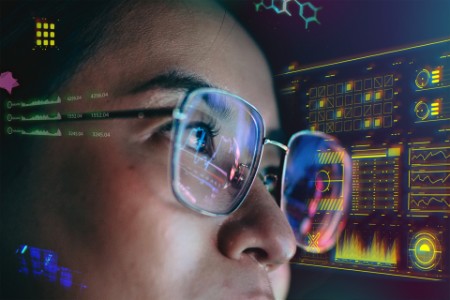
Chapter 1
A significant shift that will reshape the world
How technology has revolutionized the world and transformed society.
In 1440, the printing press was industrialised by Johannes Gutenberg; by the year 1500, approximately 20 million books had been produced in Europe. This was the first information revolution, post the invention of writing. It transformed the society and resulted in significant innovation and economic growth.
The printing press also revolutionised the flow of political information, the formation of public opinion, and the dynamics of power in politics. It democratised political discourse, enabled political movements, and fostered a more engaged citizenry. We can draw a straight line from this event to the 30-year war in Germany (1618) and the civil war in the UK (1642).
The impact of the printing press on politics continues to be felt today, as its legacy shaped the development of media, communication, and the democratisation of information.
The wave of technological innovation we are facing now is arguably more significant than the invention of the printing press. Social norms will be rewired, and society and the world will be irrevocably changed. We need to be prepared as this is not a process that will be slowed or halted.

Chapter 2
The human response to technological advancement
Due to the nature and speed of new technologies, we can no longer assess their value or risks before they’re unleashed on the world.
It is human nature to keep ourselves on the edge of our seats with innovation that changes our world. This has led to a point where we are confronted by the reality of self-generating technologies that draw on knowledge from vast and varied data sources to complete tasks in seconds that would take a human hours or days. The rapidly evolving sophistication of these tools is breathtaking and seemingly denies the time to exercise choice or controls¹. While the opportunity to choose whether these technologies are unleashed on the world before a true assessment of their value or risks is not a reality, standing on the sidelines is not an option. History highlights our inability to accurately predict the future. The ability to predict how generative technologies will evolve is significantly limited by their speed of evolution and its broad reach and application. Organisations need to assess and manage opportunities and risks at a whole of organisation level and by function.

Chapter 3
The nature and potential of generative technologies
How AI technology has evolved throughout history and what we can expect in the future.
AI has been making advancements and applications in various fields for several decades, but the scope and capabilities of AI have significantly evolved over time.
1950s-1960s
The field of AI was established, and early AI research focused on symbolic reasoning and problem-solving techniques. In 1956, the Dartmouth Conference marked the birth of AI as a formal field of study.
1970s-1980s
Expert systems emerged as a prominent AI application, where knowledge and rules were encoded to solve specific problems, but limited success in achieving human-like intelligence led to the “AI winter,” a period of reduced funding and interest in AI research.
1990s
Machine learning gained attention, with advancements in neural networks and statistical techniques. Practical applications of AI, such as data mining and natural language processing, started to emerge.
2000s
Increased computational power and availability of big data contributed to advancements in machine learning, specifically deep learning, and neural networks. AI applications expanded in areas like image and speech recognition, recommender systems, and autonomous vehicles.
2010s
Deep learning techniques fuelled significant breakthroughs in areas such as computer vision, natural language processing, and reinforcement learning. The deployment of AI systems and technologies became more widespread, impacting industries like health care, finance, and retail.
Present
AI continues to advance rapidly, driven by advancements in algorithms, computational power, and access to vast amounts of data. AI applications are becoming increasingly integrated into everyday life, including voice assistants, personalised recommendations, and smart home devices.²
Ongoing research and development in AI aim to tackle complex challenges and explore new frontiers, such as explainable AI, AI ethics, and AI in robotics and automation.
AI progress has been characterised by periods of excitement and progress, as well as periods of scepticism and slower growth. The recent advancements and applications of AI have been fuelled by the convergence of various factors:
- Bigger data sets with more data generated per day than in all history up to 2010
- Faster GPUs (hardware processing power is key)
- Open-source software (co-working on advances across a major global community)
- Data scientists (more and more highly trained scientists in this space)
The impact of all four of these factors has accelerated the development of AI, and we are at the start of an exponential development curve. Microsoft’s head of strategy reported that in the northern spring of 2022 Microsoft was monitoring 800 companies developing AI solutions, six months later it is now 8,000³.
This not only highlights the opportunity that many companies are actively pursuing but also the exponential growth in investment and development, which will accelerate the evolution of generative and other technologies.
Open access to AI chatbots and Large Language Models (LLM) have bought us to the inflection point where AI has moved from the realm of possibility to an everyday reality. These text-based tools are best at synthesising text, reviewing data models in programs such as Excel and preliminary research. Limitations include currency, completeness, and accuracy of search findings. This can result in bias, or disinformation. These weaknesses are recognised and are likely to be addressed soon though iterations of the technology.
The full potential and implications of generative technologies are both tantalising and unknowable, but we can expect:
- Continued advancements in AI technology: AI technology is expected to advance rapidly, with improvements in areas such as machine learning, natural language processing, computer vision, robotics, and neural networks.
- Increased integration of AI in various industries: AI will continue to be integrated into numerous industries, including health care, finance, transportation, manufacturing, agriculture, and customer service. AI systems will assist in data analysis, decision-making, automation, and optimisation, leading to increased productivity and efficiency.
- Growth of AI-assisted health care: AI will play a significant role in health care, assisting in diagnosis, treatment planning, drug discovery, genomics, and personalised medicine. AI-enabled systems can help health care professionals deliver more accurate and efficient care, leading to improved patient outcomes and better disease management.
- Expanded adoption of autonomous systems: Autonomous vehicles, drones, and robots are expected to become more prevalent. AI technologies will enhance their capabilities, enabling safer and more efficient operations in areas such as transportation, logistics, delivery services, and manufacturing.
- Enhanced Natural Language Processing (NLP) and Human-Machine Interaction (HMI): AI systems will continue to improve in their understanding and generation of human language, leading to more advanced chatbots, virtual assistants, and natural language interfaces. Human-machine interaction will become more seamless and conversational, enabling new ways of interacting with technology.
- Ethical and responsible AI development: As AI becomes more pervasive, there will be an increased focus on ethical considerations, fairness, transparency, and accountability. Regulations and guidelines will be developed to ensure responsible AI development and usage, addressing issues such as bias, privacy, security, and the impact of AI on jobs and society.
- AI for social good: AI will be leveraged to address social and environmental challenges, including climate change, poverty, health care disparities, education, and humanitarian efforts. AI-driven solutions will be developed to promote sustainability, equality, and social wellbeing.
- Collaboration between humans and AI: The future AI landscape will likely involve a collaborative relationship between humans and AI systems. AI will augment human capabilities, assisting in complex decision-making, data analysis, and problem-solving, while humans provide contextual understanding, creativity, and ethical judgment.
In some ways we are in a ‘dress rehearsal’. The tools are mature enough to provide us with an experiential platform to establish governance and management systems and protocols, socialise their possibilities, develop new skills, and test their application, but not yet robust enough to fully rely on.
This does not mean there is time to leisurely come to an accommodation of these new tools. There are smarter machines coming, and soon. Organisations must grab this brief window to reframe in the context of AI.

Chapter 4
Opportunity or threat
The risks of AI are real, but it’s how we manage and monitor them that will decide the outcome.
Both risk and opportunity have been the natural outcomes of innovation, but they should not be treated as binary. Major inflection points in the evolution of technology highlight their potential to both benefit and negatively impact social and economic outcomes.
Opinion is divided as to whether the risks of AI-generated technology outweigh the potential benefits. The reality is that it is unrealistic to believe that the natural evolution of these technologies can be prevented from playing out. They offer boundless opportunity. For workers, technology has led to the reduction in heavy and dangerous work and repetitive and mundane tasks. It has also generated new, more interesting, and diverse jobs, boosted productivity, supported flexible ways of working and led to better working conditions, higher wages, and a better standard of living overall.
Technologies can also demolish jobs in some areas, exacerbate the wealth divide where, at the most extreme, technology magnates control the world’s wealth, create issues of equitable access, further erode privacy, and perpetrate disinformation that can lead to social and political unrest.
How relevant the trends of the past are to an AI-driven future is unknown, it may be that the trend remains constant with AI unleashing the next generation of innovation, driving new areas of work and continuing to expand the global demand for talent. Or AI may be the indicator of a different future where increasingly sophisticated technologies are able to undertake the full range of complex tasks that were previously the sole domain of humans and where the real and virtual worlds become indistinguishable.
It is undeniable that the risks are real and must be monitored and managed more proactively than in the past. This technology has no regard for geographic borders, so regulation and controls are more likely to be effective if there is consistency across nations.

Chapter 5
A fortunate coincidence
Generative technologies present an opportunity to sustain performance by shifting the balance from people to process as the central pillar of productivity.
Timing is everything. The rise of technologies that have the potential to replace human endeavour in a period where growth in the global working-age population is in steep decline may be an example of extraordinary synchronicity.
People have historically been the central plank of productivity with a growing and more educated population underpinning increasing capability and capacity. This era is coming to an end.
Over the past 50 years (1980–2021), the global population increased by 78%. Over the next 50 years, growth is forecast to fall dramatically to 28%.4
At the same time, growth in the global working-age population will more than halve from 190% over the last 50 years to 80% over the next 50 years.5
The picture is even more stark for developed economies that are already experiencing negative natural population growth due to low fertility rates. These economies are reliant on migration to realise population growth and to balance labour supply to demand.
This highlights both the challenge to continue productivity gains and related economic growth and the opportunity that generative technologies present to sustain performance by shifting the balance from people to process as the central pillar of productivity.
Technology has accounted for most productivity gains since the 1990s and while forecasts vary, it is generally agreed that generative technologies will underpin and accelerate productivity over the next few decades.6,7
Rather than the portent of doom, generative technologies can offset the impact of slowing population and workforce growth and deliver solutions that will advance all areas of the economy and society.

Chapter 6
Lessons from history
What lessons can we learn about new technologies from history.
History provides us with valuable lessons about the impact of new technologies. In framing a response, it is useful to consider our experience with technology over time.
Lesson 1: Resistance is futile
Throughout history, the introduction of disruptive technology has been met with both excitement and resistance. The lesson is that resistance is futile. There is no example of a viable technology that was held back if it had a practical application.
The evolution of social media gives us a recent example. Most organisations banned or took measures to limit access to social media platforms in the workplace. Instead, they invested in internal tools that were quickly redundant once the permeable nature of social media was accepted.
Lesson 2: Expect the unexpected
A linear view of the future is often the default, it is easier to imagine a future that is built on the current state than it is to consider and assess the many latFeral paths the future can take.
It is usually the convergence of both technologies and supporting infrastructure that direct the path development takes. An example of this is the maturity of the internet marketplace. Early forays into online retail largely failed due to the lack of supporting infrastructure such as digital payment and streamlined logistics but once established it drove a boom in online sales that has significantly disrupted traditional retail.
The fast-paced evolution of AI technologies will introduce a higher order of complexity to strategic planning within organisations. It will demand considerations of different scenarios across several horizons and planning cycles that match the dynamic nature of technology-driven change.
Lesson 3: The echoes of the future are present today
Even when the indicators of the future are present, they are often ignored. Our common view of global population trends is a good example. While most people believe that populations will continue to grow exponentially into the foreseeable future, the known reality is the opposite. Somewhere between the mid-point and end of this century the growth in global population will decline, and this decline is likely to accelerate into the next century if trends remain constant.4
Another example of missing the signposts to the future is the ‘Great Horse Manure Crisis of 1894’ where major cities such as New York and London were overwhelmed as horse numbers grew and there was no easy solution for the disposal of the quantities of manure being produced. The Times newspaper predicted that ‘in 50 years every street in London will be buried under nine feet of manure’. This was even though by the 1890’s motor cars had reached their modern stage of development and would quickly replace horse-drawn vehicles.
Significant resources will be expended on redundant problems and opportunities missed if all leaders are not actively monitoring emerging technologies and considering their implications.
Lesson 4: It only gets faster
Every tranche of new technology across history has accelerated the cycle of innovation. Since the introduction of the internet and digital technologies the pace of change is unprecedented. The ability to tap into the global pool of knowledge, to communicate, cooperate and innovate across geographic boundaries in real-time, and to rapidly test and iterate have driven the shift from cyclical to dynamic change. In this context, there is no option but to accept that change is constant and to embed agility into all aspects of an organisation.

Chapter 7
Implications for regulators, organisations and people
What’s in store for regulators, organisations and people, and what we need to know.
Regulators
Historically regulation has lagged the introduction and adoption of transformational technologies. This has resulted in negative social, political and economic outcomes. The risks this next generation of technologies presents is even more significant than those in the past. Immediate threats such as data privacy and security are already apparent. The broader threat of substantial job loss, that reinforces the disadvantage gap, particularly amongst low skilled workers will result in social and political ramifications. There are also significant political threats that were highlighted through recent US elections.
These threats have been loudly promoted by tech leaders and jurisdictions are responding. The EU has passed an Artificial Intelligence Act which includes approval processes for new technologies before they can be taken to market and the limiting the use of facial recognition technologies.
Managing the direct risks of generative technologies through layers of regulation may be the immediate focus but as important is the consideration of how these technologies challenge broader regulatory frameworks. In the same way the adoption of electric vehicles is challenging fuel taxes and excise, generative technologies will over time challenge all aspects of our regulatory and legislative environment from taxation to labour, communication to pension systems, roads to privacy, health to finances.
Organisations
Generative technologies present the opportunity for organisations to drive productivity and innovation, but like every other disruptive technology they also present the risk of loss of competitive advantage, change resistance, and workforce disruption. Translating a risk-based approach at the organisational level makes sense, but it must not create a level of conservatism that compromises innovation or delays transformation.
The starting point to agree an ethical framework for the organisation that will act as a touchstone to how AI is adopted and deployed. EY’s responsible AI principles offer a starting point.
EY responsible AI principles:
- Accountability: unambiguous ownership over AI systems, their impacts and resulting outputs across the AI lifecycle
- Data Protection: Use of data in AI systems is consistent with permitted rights, maintains confidentiality of business and personal information and reflects ethical norms.
- Reliability: AI systems are aligned with stakeholder expectations and continually perform at a desired level of precision and consistency.
- Security: AI systems, their input, and output data are secured from unauthorized access, and resilient against corruption and adversarial attack
- Transparency: Appropriate levels of disclosure regarding the purpose, design and impact of AI systems is provided so that stakeholders, including end users, can understand, evaluate and correctly employ AI systems and their outputs.
- Explainability: Appropriate levels of explanation are enabled so that the decision criteria and output of AI systems can be reasonably understood, challenged and validated by human operators.
- Fairness: The needs of all impacted stakeholders are assessed with respect to the design and use of AI systems and their outputs to promote a positive and inclusive societal impact.
- Compliance: Ensures the design, implementation and use of AI systems and their outputs comply with relevant laws, regulations and professional standards.
- Sustainability: Considerations of the impacts of technology are embedded throughout the AI lifecycle to promote physical, social, economic and planetary well-being.
AI generative technologies are moving quickly. To keep up organisations must closely monitor their evolution and continually update strategy to capture emerging opportunities.
Priority should be given to:
- Engaging and educating leaders in the development and application of AI
- Establishing systems and processes to stay abreast of developments and to make decisions about their application
- Reviewing the operating model to ensure a fit to an AI future
- Educating and engaging people in the organisation’s visions for AI technologies
- Investing in new skills to accelerate productivity through and AI people partnership
- Testing and learning, with the immediate opportunity being the managed use of language models and the evolving ecosystem of consumer facing AI chatbots and AI powered tools.
Over time it will be necessary for organisations to rethink the total enterprise to unlock the full potential of AI.
The implications for people and jobs
For now, you are not going to lose your job to AI, but it will definitely change your job and you might lose it to someone who can use AI better than you.
Comfort is taken in the narrative that machines will not replace the human ability to empathise, contextualise, innovate, apply moral reasoning, understand causality, observe, and interpret, or to be creative, kind, or resourceful. Or to negotiate, resolve conflict, and communicate through dialogue. These innate human characteristics are thought to protect us against total obsolescence.
Research also indicates a human bias against machines. Our preference is to interact with another person, which may preserve the role of people as the human interface. The question is - will this be sustained as people become more comfortable with interacting with machines and machines become more efficient, effective, and trustworthy.
The overall impact on jobs cannot be predicted, forecasts range widely from the dystopian view of total job destruction to a positive outlook where technology drives unprecedented productivity and innovation, leading to the creation of new, more interesting, and diverse jobs.
The impact will inevitably come in waves, automation and augmentation of tasks already touches all areas of work. Initially these have been more routine activities but over time more sophisticated technology will shift up the skill ladder to higher order tasks with nine out of ten new jobs predicted to require post school qualifications.
Job redundancy is a reality and in the immediate future is likely to be concentrated in low skilled or routine jobs that are more easily automated. Autonomous trucks are here and could replace 4 million driving jobs in the US alone. At the same time fully automated warehouses stand to replace 1.4 million warehousing jobs and 3.6 million cashiers are at risk of job loss due to AI.
The World Economic Forum predicts structural growth of 69 million jobs and the decline of 83 million resulting in a net loss of 14 million jobs over the next four years (WEF 2023). This churn highlights the challenge of preparing people for newly created jobs and managing the impact of job loss. There are already many examples of where organisations are reshaping their workforces in response to AI generative technologies.
IBM is reducing its recruitment intake by 7,800 for mainly back-office roles, British Telecom has announced it is cutting 30,000 jobs by 2030, 10,000 of which will be replaced by AI and in Australia, a new digital radio start-up announced it has hired a veteran newsreader and an AI robot as its news team.
Some of the more immediate people challenges to include:
- Promoting awareness of technology driven change and its impact on work
- Culturally aligning people to embrace change, collaborate, innovate, and effectively partner with technology
- Engaging people in skilling and reskilling in line with changing capability requirements
- Establishing systems to dynamically forecast and allocate resources against capability and capacity requirements
- Redefining the role and entry point for graduates as data analysis, document review, research and simpler writing tasks are automated

Chapter 8
Summary
How can we help support your people agenda.
Every era of major evolution in technology has disrupted social and economic norms and has had negative impacts on some groups in the short term. Overall, history shows that new technologies have driven economic growth and improved work and living standards.
Whether generative technologies follow the path of history is uncertain. The forecast ability of these technologies to replace rather than augment people is profound. It has the potential to drive unparalleled productivity gains, innovation, and new areas of work, realise aspirations of work-life balance, and free people from more dangerous and mundane tasks.
It also has the potential to result in serious social and economic disruption. To avoid this, both employers and government need to get ahead of the future and consider how those displaced from work through technology are supported to meaningfully contribute and share in the economic benefits. Early forays into areas such as universal incomes and reduced working weeks provide some useful experience but these must be considered as part of a systemic response.
At the organisational level, leaders must set an informed and intentional course of action that is founded in shared ethical standards, that places people at the centre and drives a culture of enthusiasm towards the future and the opportunities presenting, while monitoring and managing risk.
Contact us
We are excited to work with you to explore how GenAI can support your people agenda. For further queries, please reach out to Juliet Andrews.
Related articles
Summary
Explore the impact of the explosion of new generative technologies on the world of work, including organisational, leadership and workforce implications.


